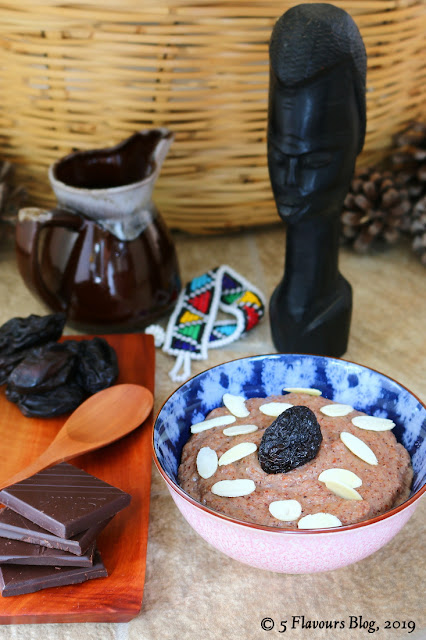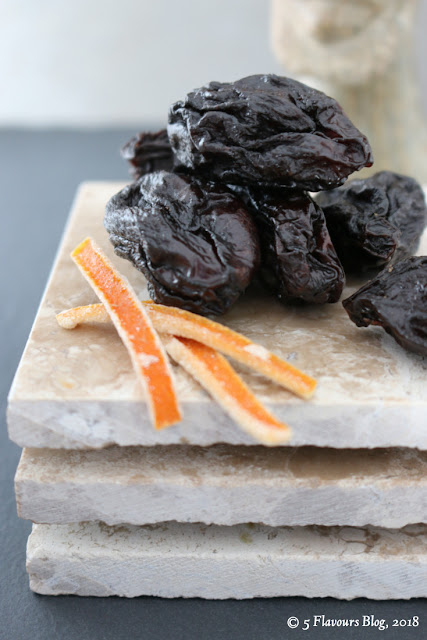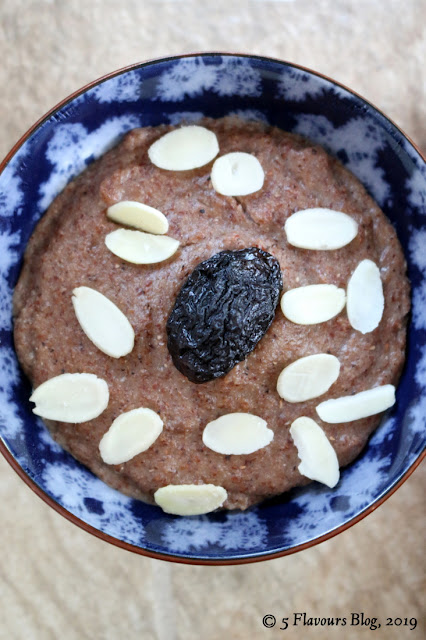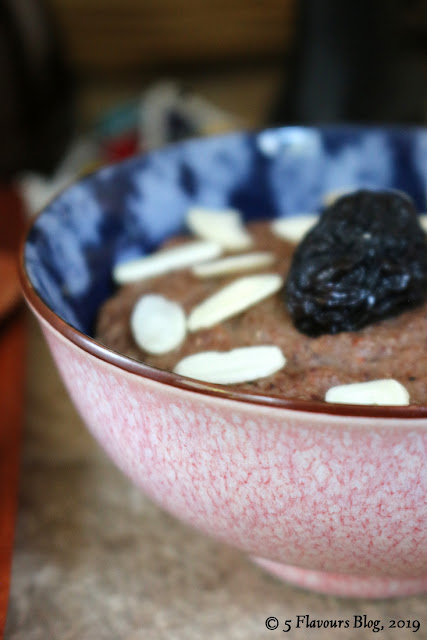Creamy Sorghum Mush with Orange Peel & Prunes
In certain respects sorghum, in all its various guises, is Africa’s
“venerable Old Man”. Sorghum’s African history and influence predate that of
maize, which is quite an achievement by itself. Yet sorghum has escaped the imperious
technological improvements that Westerners – in their seemingly incessant
hunger to elevate the lives of those they deem “less fortunate” – so freely
(and magnanimously) bestow on agricultural products deemed worthy of
patronising attention and inevitable financial gain.
Deceptively simple, yet rich, comforting and indulgent, sorghum mush is
regionally also known as Mabele porridge (pronounced ‘Mha-bê-lê). Almost all white South African pre- and primary
school aged children from the 1960’s to 1990’s knew this as “Matabêle” or “Maltabella pap” – a reference to the Matabele warrior tribe of southern Zimbabwe. Slogging off to school with a belly of stodgy Matabêle pap and lukewarm milk, I frequently
marvelled at how impi’s (battalions)
of blood thirsty warriors could rush hell for leather into fierce battle with
stomachs full of this stuff sapping will power and courage.
For the record: ‘pap’ is the
one-size-fits-all, collective Afrikaans term for porridge, mush and gruel. We
like our words to work hard in Afrikaans.
My primary school experience was that Mabele porridge (or mush, to be
accurate) was invariably either intensely disliked by white children or they
had an inordinate fondness for it. There were absolutely no gustatory inbetweeners
when it came to this fairly quaint breakfast item – irrespective of how much our
well intentioned mothers tried to dolly it up beforehand. I suspect many black
children of that era did not have the luxury of choice in personal predilection
towards Mabele.
In Africa, the Wheel of Time turns slowly but inexorably. And if the
armchair philosophers are to be believed, we reflect increasingly in middle
years on our Youth – misspent or angelic – and draw conclusions, sometimes
deeply personal and or profoundly embarrassing. Extreme cases even try to
revisit events or the places of their Youth: detrimentally or beneficially.
One of my middle aged predispositions consists of revisiting the dishes
of my youth. Surprisingly, a cautious recent bout of Mabele mush nostalgia was
a pleasant return to the far-off days of yore. Possibly harvesting and milling technology
(and modern sorghum cultivars) have improved over the intervening three and a
half or so odd decades, but I find sorghum mush today to be far more palatable and
endearing / charming than what I remember from primary school days.
South Africa was maybe not quite at the finely honed cutting edge of
international health-and-balanced diet research during the late seventies and
early eighties of the preceding century. This, however, did not deter most housewives
and mothers from doing their best at providing their families with a balanced,
nutritious diet with what they had at hand then, both information and resource wise.
Mom, in step with most stay-at-home, middle class wives of that more naïve era,
was no exception. Our family had to endure – with varying degrees of patience –
several dietary ‘fads’ over the years. Maltabella
pap was – with snotty, juvenile wisdom – scornfully regarded as one of
these.
Back then, Mom’s Maltabella pap
was a stodgy, dark brown affair with a singular super power: while hot it would
surreptitiously consume spoons if your attention wandered; yet, when cool, it
would take on the consistency of plastering cement well past its prime. It was
mandatory to thoroughly sweeten it. Even then it had a peculiar, somewhat musky
and earthy taste that took a little getting used to. Dearest Mom served it
quite hot and we were encouraged to work in a healthy dollop of butter or
margarine and pour some cold milk over if too hot. Additional sugar was frowned
upon, but grudgingly allowed or we would never eat that stuff. And then you had
to shovel it down with alacrity lest the Dreaded Stodge set in …
The commercial, boxed product of the 1970’s and 1980’s, as today,
consisted of malted (germinating cereal grains that have been sprouted, dried
and ground) sorghum meal. Then, as now, it had a pinkish-brown, speckled
appearance with a soft, sweet and quite agreeable, grain-like odour.
Unsurprisingly, Mabele’s innocuous demeanour changed significantly once cooked,
plated and presented to a sullen, rebellious audience not in the mood for
somewhat desperate assurances of “it’s-sooo-good-for-you
...”
Maybe three and a half preceding decades have abraded my not so positive
recollections of Mabele, or the cultivars and grain processing methods
improved, but today I find Mabele quite agreeable. It’s a little bland, but
still possesses that distinctive and charming contrast of silky creaminess
indelibly bound with moderate grittiness.
This recipe is a modern translation of what is fast becoming a favoured,
personal indulgence. However, I have come to realise over the past few weeks
that it is not quite all moonshine and roses in the Land of Mabele. Akin to all
things that seem simple and straight forward at first glance, sorghum meal is
neither. Inevitably, there are a few observances that have to be noted:
- Sorghum meal cannot be added directly in dry form to the boiling liquid it is to be cooked in. Add it as a slurry with copious, simultaneous stirring or it will form lumps with rambunctious exuberance.
- Once added, the proto-mush needs near continuous stirring during the initial ten or so minutes as the meal does not stay in suspension in the simmering liquid until it has absorbed a significant quantity of said cooking liquid. Failure to enthusiastically stir initially will result in a dense layer of stodge on the bottom of the cooking vessel. Stirring this recalcitrant lot up leads to – yes, you guessed it! – multitudinous lumps. You cannot leave the submerged stodge either as it chars with gay abandon.
- After this initial period of vigorous dread, the mush has to be cooked over very low heat – barely simmering – or it will actively splash up and deposit much of itself against the sides and lid of the cooking vessel. Frequent stirring is still mandatory at this stage or the dreaded layer of Stodge ensues at the bottom of the cooking vessel. Be careful with the stirring: the splashing of the cooking mush will seem deceptively languid and peaceful, enough to draw an incautious hand too near . . . with Vesuvian results.
- The slowly cooking meal absorbs a surprising volume of liquid, whether it be water or milk. Additional portions of hot cooking liquid are required from time to time to prevent the forming mush from turning into a primordial, gloopy stodge.
- Remember to regularly scrape the bottom ‘corners’ of the cooking vessel or pot with a spoon if the vessel does not have a fairly ‘loose’ radius where sides and bottom meet. That ‘corner’ is a favourite collecting area for the cooking mush to assemble into a layer of stodge that takes a surprising level of effort in the kitchen zinc to clean off.
- Serve the cooked mush quite hot as it thickens impressively on cooling, thus losing its charming, gritty silkiness.
Small wonder then that Mom’s hasty breakfast efforts frequently turned
out less than perfect. However, despite the above precautions, the game is
still worth the candle!
Interestingly, neither decades of relentless, continuous milling
technology improvement nor selective, ennobling breeding could eliminate the Dreaded
Stodge so unnervingly endearing to Mabele mush. Some habits resist ‘Progress’
with unrepentant glee.
For this recipe, a dash of cocoa positively enlivens the somewhat drab
flavour profile of Mabele. In turn, candied orange peel “simply does” for the cocoa. The dark, seductive fruitiness of the
dried prunes bind the entire ensemble together into an alluring whole that
charms and delights the mouth and being (notwithstanding the dedicated
attention required to achieve mushy success).
Beware going overboard with the dried prunes.
Their reputation for natural laxative encouragement is well founded.
Recipe yields:
2 Portions
|
Preparation time:
± 5 Minutes
|
Cooking time:
± 25 Minutes
|
Difficulty level:
Fairly easy
|
Special Equipment Required:
1
x Medium, heavy bottom saucepan with lid
1
x Medium, balloon style wire whisk
Ingredients:
Full cream
milk
|
250ml
|
Sorghum meal
|
150ml / 100g
|
Water, room
temperature
|
150ml
|
Brown sugar
|
45ml
|
Candied orange peel, chopped
|
10ml
|
Cocoa,
powdered
|
5ml
|
Ground
cinnamon
|
1.2ml
|
Hot water
|
100ml – 200ml
|
Dried prunes,
moist & soft, pitted
|
8
|
Salt
|
± 2ml
|
Optional:
|
|
Fresh cream
|
30ml
|
Toasted almond
flakes
|
15ml
|
Method:
- CAREFULLY bring the milk to boiling point over medium heat
- Mix the sorghum meal, sugar, orange peel, cocoa and cinnamon together in a separate bowl. Add the water and mix to form a thick slurry. Add this slurry to the milk once it is boiling and whisk vigorously to disperse all the solids and dissolve the sugar.
- Adjust the heat to low, stir nearly continuously and bring the contents of the pan up to simmering point. Adjust the heat to very low – the contents should be barely simmering.
- FREQUENTLY whisk the barely simmering, thickening liquid as the solids tends to separate out and form a thick, gummy layer on the pan’s bottom that chars easily.
- When the contents start to thicken significantly (after ± 12 – 15 minutes), the lid can be placed on the pan and the stirring reduced to moderately frequently. Gradually add the second batch of hot water in small increments to maintain the desired consistency of the slowly cooking mush.
- Gently simmer for 15 – 20 minutes depending on the desired consistency. Remember to frequently scrape the circumferential bottom ‘corner’ of the pan to collect and disperse any solidifying material hiding there.
- Add the salt and dried prunes when the mush is deemed almost ready. Taste and correct for salt and sweet to personal preference.
- Remove from the heat, allow to cool 3 – 4 minutes (no longer) and serve to great acclaim.
Comments:
- Sorghum meal is generally not of homogenous consistency. It contains a fair percentage of gritty material, albeit nearly invisible but still ‘mouth detectable’ in the final dish. I prefer a longer than usual simmering period to reduce this graininess. However, this is my persnickety preference. Generally, 20 – 25 minutes will be sufficient to thoroughly cook the mush and subjugate all excessive graininess.
- Keep an eye on the milk while heating it to boiling point. Serenely heating milk has an obscene, masochistic joy in boiling over when the cook looks away for longer than 1.252 seconds. The result is invariably messy and smelly.
Sometimes
confused with millet, Sorghum bicolor is native to Africa
south of the Sahara and is at present cultivated in many forms the world over.
Of the 25 or so Sorghum species, only
S. bicolor is used for human consumption.
The name "sorghum" originates from the Italian "sorgo", which in turn is a
contraction from Medieval Latin: Syricum
(granum), meaning "grain of
Syria".
Until
relatively recently, sorghum was known in scientific botanical and agricultural
circles as Sorghum vulgare, the “vulgare” being a direct reference to its commonness. And maybe an indirect
hint at its social status in the world at large. The present bicolor refers to the two major color
varieties cultivated for human consumption:
- White grained for food products, and
- Red seeded primarily intended for beer production.
- Food,
- Animal fodder,
- Alcoholic beverages, and
- Biofuels.
Sorghum
was probably first cultivated in Ethiopia somewhere between 4000 to 3000 BCE.
From there it spread to West Africa, the Near East, India, China, and – later –
to the New World. Archeological evidence is incomplete, but finds so far
indicate wild sorghum was used between 800 – 600 BCE in Egyptian Nubia. The
Muslim Agricultural Revolution drove its export from thereon to the Middle East, North Africa and Europe
initially. Some of the older names for sorghum include durra, Egyptian millet, Guinea corn, milo, Sudan grass, jola and jonnalu. Interestingly, the Romans were not familiar with sorghum. It
was the Muslim Moors who introduced sorghum to Europe in medieval times via
their occupancy of the south-west of Spain.
In
the less developed regions of the world, sorghum is used to make foods such as couscous,
sorghum flour, porridge and molasses. “Mabele” is the South African, Northern
Sotho name for the stiff porridge prepared from the meal. It is also descriptively
known as “Brown Porridge” among the local white, English speaking community.
In
the Southern African region, sorghum meal intended for Mabele porridge is produced
from the red grain bicolor varieties
and is quite finely ground. Roughly milled sorghum meal is also available and
is known as “Ting” in black communities. The rough meal forms the basis, in
conjunction with maize meal, of the traditional soft and stiff sour porridge “Bogobe ba ting” (a.k.a. “ting ya Mabele”).
Sorghum
beer production is another major local use for ‘red’ sorghum grain. The beer is
brownish-pink in appearance and has a robust, fruity and sour taste with an
alcohol content of 1% - 8%. It is unfiltered, cloudy and has a distinctly
grainy to gritty texture. Consumed at room temperature, sorghum beer is an
efficient thirst quencher. It is popular amongst South Africa’s black
communities and is considered the traditional drink of the Zulu nation.
Sorghum
as a staple has several dietary and health benefits:
- High nutritional value
Sorghum is about 70% starch (mostly amylopectin). After starch, protein is the main constituent. In fact, sorghum has ±22 gram of protein per cup (192 gram) serving of the cooked whole grain. This is considerably reduced in the processed meal, yet it still contains significant quantities of iron and phosphorus. The meal is also a good source of magnesium, copper, calcium, zinc and potassium. - Antioxidants
Sorghum contains a variety of beneficial phyto-chemicals that act as cellular antioxidants. - Digestive health
- Gluten free
Sorghum starch contains no gluten, nor its precursors: glutenin and gliadin. This makes sorghum eminently suitable for those with gluten sensitivity or celiac disease. - Non-genetically modified
Despite being the 5th most produced cereal crop globally, it is still (so far) genetically unmodified. Apparently the DuPont Pioneer Company is working to develop a “bio-fortified” strain with high vitamin A levels, more readily absorbed iron and zinc, and an improved balance of amino acids.
© RS Young,
2019
Follow Me on Facebook
Sources:
1.
Wikipedia: Commercial Sorghum; https://en.wikipedia.org/wiki/Commercial_sorghum;
Retrieved 20/06/2018.
2. THE
PENGUIN COMPANION TO FOOD; Davidson, Alan; Penguin Books (U.K.);2002.
[Originally published as the “Oxford Companion To Food” in 1999 by Oxford
University Press].
3.
Wikipedia: Arab Agricultural Revolution; https://en.wikipedia.org/wiki/Arab_Agricultural_Revolution;
Retrieved 20/06/2018.
4.7
Benefits of Eating Sorghum;
https://www.care2.com/greenliving/7-benefits-of-eating-sorghum.html; Retrieved
21/06/2018.
Image Credits:
1.
grain-sorghum.jpeg Source: https://roundstoneseed.com/wildlife-food-plot-seed/177-grain-sorghum.html
Note:
Post
updated on 2024.02.10 to include:
1.
The updated Recipe for downloading as a PDF file, and
2.
Recipe Title and Print Recipe, Recipe Index and Facebook & Pinterest follow
links.












Comments
Post a Comment